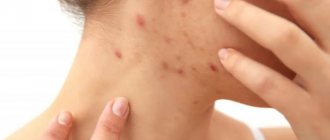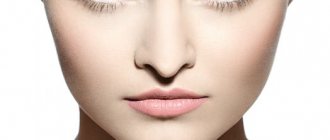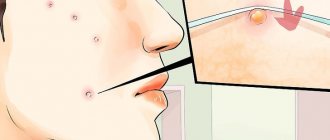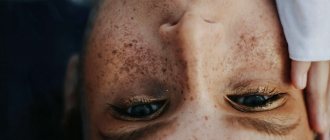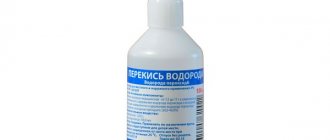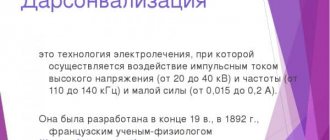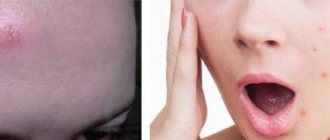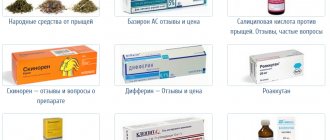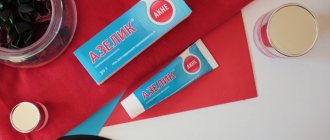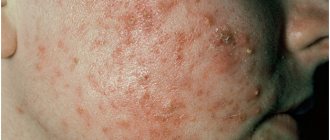Why does skin become problematic? The reason is the activity of the sebaceous glands of the skin, located in its deep layers. Based on the amount of sebum secreted, the skin is divided into three types - dry, oily, normal, and combination skin is also found, the type of which varies in certain areas. Oily (whole face) and combination (oily skin in the T-zone - nose, forehead and chin) skin are characterized by large sebaceous glands with abundant sebum secretion and wide openings, which are popularly mistakenly called “pores”. Most people believe that these "pores" or "blackheads" are glands in the skin that should be treated with creams and ointments. However, the sebaceous glands themselves are located deep, in the lowest parts of the skin, from there comes a thin convoluted excretory duct, which opens at the mouth on the surface. Therefore, so often the use of only creams and lotions to treat deep acne is ineffective.
What are the sebaceous glands for?
Normally, the sebaceous glands are designed to produce sebum in order to protect and strengthen the skin, but under the influence of improper care, poor ecology, nutritional habits and hormonal levels, their work malfunctions.
In addition to the volume of sebum secreted, its thickness also matters. The thicker the secretion, the more difficult it is for it to come out. The abundant thick secretion literally “bursts” the walls of the gland, which is why seals of different diameters are visible on the skin: from tiny balls to quite large nodes, over which the color of the skin can even change, acquiring a slightly bluish tint. The accumulation of sebaceous secretions attracts bacteria that live on the skin, since sebaceous secretions are an excellent breeding ground for them. As they multiply, they cause inflammation, soreness and redness of the skin. When the main defect is not eliminated - stagnant accumulation of sebum - such local inflammation can “smolder” for weeks, forming acne or pimples.
Based on the above, there are three steps to healthy skin.
A difficult pimple is worse than a difficult teenager
The owner of a pimple, wanting to get rid of such a dubious “decoration” as quickly as possible, often tries to squeeze it out, but nothing works, since the stagnant secretion simply cannot pass through the narrowed duct of the sebaceous gland. Another option for the wrong approach to the problem is burning the skin over the pimple with various solutions, ointments and creams. But they are not able to penetrate the deep layers of the skin and open the stagnant conglomerate. Gradually, a chronic pimple goes away on its own, but in its place a bluish, then brownish pigmentation, and often an atrophic scar, remains for a long time.
What to do?
In order for a stagnant pimple to go away quickly, it is advisable to help the skin get rid of it. It’s very simple - you need to use a method called electrocoagulation with “opening” the channel to remove the contents of the pimple, and then inject an antibiotic or an oxygen-ozone mixture under it to quickly suppress bacterial inflammation. After such manipulation, healing proceeds very quickly, however, pigmentation and a scar can still form, therefore, as soon as a pimple has formed, it is advisable to consult a dermatologist.
Atrophic scars after acne can be eliminated with injections of high molecular weight hyaluronic acid and regular application of retinol cream. The younger the scars, the better they respond to treatment. For the same purpose, as well as to even out skin color, superficial-medium peelings are used, which stimulate skin renewal and actively exfoliate its upper layers. Usually these are 4 procedures at intervals of a month. They are carried out in the autumn-winter period (from October to February), when the sun is not very active, and the likelihood of abnormal pigmentation after the procedure is low. The resorption of bluish spots can be significantly accelerated with the help of oxygen-ozone therapy and mesotherapy with vitamin complexes and antioxidants.
Painful pimples* on the face: the cause of pain in women and men
Acne can be non-inflammatory (open, closed comedones) and inflammatory (papules, pustules, cysts, etc.). Non-inflammatory acne elements, as a rule, only cause aesthetic discomfort, but inflammatory acne elements can cause pain.
The inflammatory process is the primary link in the pathogenesis of acne. It can develop even without the participation of propionibacteria. Inflammation of the pilosebaceous follicle provokes hyperkeratosis, obstruction of the sebaceous gland channels19.
Neutrophilic leukocytes are attracted to the site of inflammation, which contributes to the formation of papules and pustules. The vessels around the inflamed area dilate, and swelling of the follicle appears. It can be felt by palpation, but pain can be felt even if you do not touch the elements of the acne.
Many people think that by squeezing a pimple they will relieve themselves of unpleasant sensations. But when the follicle is destroyed, the contents of the pustule (sebum, pus, fatty acids) enter the deep layers of the skin. These substances provoke irritation and new inflammation, which affects surrounding tissues. As a result, you may notice the rash spreading even more.
Allergic origin of acne
In some cases, acne on the face is of allergic origin and is associated with intolerance to certain types of food. Then the rash intensifies after various kinds of feasts. Such patients are characterized by a combination of skin rashes with other manifestations: for example, fatigue, headache, digestive disorders, bad breath, general skin sensitivity with a tendency to itching and redness. A surge in requests from patients with this kind of acne to a dermatologist is observed after the New Year celebrations, and in the summer - after returning from a vacation from Turkey and Egypt with their abundant buffet.
What to do?
For rashes associated with food intolerance, the best treatment is to select a diet based on an analysis of the patient's eating habits and the doctor's recommendations for replacing certain types of foods with healthier ones.
Leather and ecology
An important factor in the development of “acne” is the thickening of the uppermost layers of the skin, which narrow the excretory duct of the sebaceous gland and contribute to stagnation in it. Thickening of the skin develops in response to external influences, for example, solar radiation and unfavorable urban ecology. Many people suffering from acne notice improvement in the summer while relaxing at sea. This occurs due to the beneficial effects of fresh air on the skin. However, upon returning to the metropolis after 10-20 days, the condition of the skin worsens, affecting its thickening, which developed during tanning as a protective reaction to solar radiation.
What to do?
For such patients, chemical peels are an excellent treatment, thinning the top layer of skin and freeing up the obstructed sebaceous gland duct. Peeling with beta-hydroxy acid is ideal, which not only thins the top layer of skin, but also has a disinfecting and anti-inflammatory effect. When applying peeling, an immediate effect is observed in the form of drying out of the inflammatory elements. In some cases, other types of peelings are used: with glycolic, lactic and other fruit acids, and retinol. The doctor decides which type of peeling will be most optimal in each specific case. Usually this is a course procedure consisting of 4-10 peelings once every 7-14 days, which are carried out in the autumn-winter period. However, according to indications, some types of peelings can be used in the summer. This is a well-tolerated, quick procedure that takes 10-15 minutes.
Attention! Do not confuse chemical peeling with scrub or gommage, which mechanically cleanses the surface of the skin. The last two products are used to prevent acne and increase the effectiveness of washing. Moreover, if there are active inflamed pimples on the skin, these products cannot be used, as they can injure the skin and spread infection over its surface.
Red pimples
If red pimples appear on the face or body, this indicates that there is some kind of problem in the body. Such a rash not only spoils the appearance, but also causes physical discomfort, as it is accompanied by itching.
Papules, or small red pimples, are one of the most common types of acne. Initially, redness appears on the skin, and then numerous tubercles with a white pustular head appear. Affected areas of skin can occupy up to 50% of the surface of the facial skin, so they are difficult to disguise.
Red pimples: causes
The rash develops when the sebaceous glands become clogged with excess sebum. This happens if a person does not follow the rules of hygiene, wears too tight clothes that do not allow the skin to breathe, or uses low-quality or inappropriate cosmetics. Fans of canned, fried, and spicy foods often suffer from red acne.
Small acne on the back often occurs in athletes during heavy training and in people who engage in physical labor. This happens especially often in hot weather, when sweating is increased.
In addition, the causes of red pimples can be:
- allergic reactions;
- endocrine disorders;
- hormonal changes.
If a rash regularly appears on the cheeks, it is worth suspecting malfunctions in the intestines and stomach. Localization of lesions in the eyebrow area may indicate liver disease.
Large red pimples on the face are especially unpleasant. They bring itching and pain, make you feel complex, because your appearance changes for the worse. They are caused by factors such as:
- oily seborrhea;
- dermatological diseases complicated by infection;
- subcutaneous mite;
- excessive production of testosterone in women;
- diseases of the thyroid gland, kidneys, gastrointestinal tract;
- problems in the genitourinary area.
What to do if red pimples appear?
Many people start with home remedies - antibacterial soap, moisturizing lotions, rubbing with ice cubes, smearing with aloe juice, burning with alcohol or iodine. Unfortunately, some people cannot resist and squeeze out pimples, after which the problem only gets worse as new foci of infection are added.
In any case, it is not always possible to cope on your own, because the reason for the appearance of red pimples is a malfunction in the body. A quick and lasting result can only be obtained by visiting a dermatologist.
The Private Practice clinic employs specialists with extensive experience and solid knowledge. Before starting treatment for red pimples, they find out the cause of the skin rash. To do this, the patient is prescribed blood tests, and, if necessary, a consultation with a therapist.
An individual treatment plan is drawn up for each patient. It includes the necessary medications - ointments, vitamins, bactericidal preparations, and so on. This eliminates the factor that causes acne.
We also use effective salon procedures - professional facial cleansing, acid peeling, masks. Ozone therapy destroys pathogenic flora, stops inflammation, and regenerates the skin surface. Mesotherapy - subcutaneous injections of medicinal cocktails - affects the problem area, kills harmful microorganisms, normalizes the functioning of the sebaceous glands, and reduces scars.
All procedures are carried out in comfortable conditions by competent and attentive doctors. To consolidate the results obtained, follow the recommendations given by our dermatologists.
You can make an appointment with a doctor by calling
+7+7 (495) 980-13-16
Skin and hormones
For teenagers and young adults, the main reason for the development of acne is a sharp increase in sebaceous secretion and thickening of the upper layers of the skin from the onset of puberty.
What to do?
In this case, the ideal solution would be a combination of local homeopathic treatment aimed at liquefying thickened sebaceous secretions and the use of peels with salicylic or glycolic acid. In the acute period, when there are bright red swollen nodules on the face, electrocoagulation, local antibiotic or ozone therapy will be effective. In the first stages of treatment, the so-called “cleaning” may be advisable, when the sebaceous glands are mechanically freed from the secretions that clog them. Cleansing is not a truly therapeutic measure, since in the absence of systematic treatment, the sebaceous glands very quickly become clogged again, but in the first stages it can be useful in ensuring access of medications to the walls of the gland.
In some cases, an undeservedly forgotten quartz lamp, which was previously widely used to treat skin diseases, gives a very good effect on inflammatory acne. Currently, such a lamp can be purchased at home. However, only a specialist can give recommendations on purchasing such a lamp and recommend a course, since in some cases its use will be contraindicated, which, however, applies to any method of treatment.
Painful pimples* on the face: causes and treatment
Painful rashes appear for a number of reasons, here are some of them48,49:
- Changes in hormonal levels. This is especially common among girls before menstruation and adolescents during puberty.
- Poor nutrition. Excess dairy products, fatty, sweet foods.
- Mistakes in hygiene. Its excess or deficiency.
- Genetic predisposition. A family history of acne increases the likelihood of developing acne.
- Taking certain medications. Glucocorticosteroids and some other medications can cause acne.
A dermatologist treats acne. For mild to moderate acne, the doctor may prescribe medications with azelaic acid, for example, Azelik®5,9 gel. It should be applied to previously cleansed, dry skin5. The doctor may also recommend combination therapy: the use of Azelik® gel and Clindovit® gel (topical antibiotic).
*acne
Skin and age
Acne often bothers middle-aged people, when the first wrinkles already appear, but the “problematic” skin still persists. The reasons are age-related thickening of the skin, decreased local immunity and endocrine disorders. At this age, acne is located mainly along the oval of the face and on the cheeks, where thin convoluted glands lie.
What to do?
The optimal result is achieved by combining peeling with mesoimmunocorrection. Mesoimmunocorrection is the use of mesotherapy products with hyaluronic acid, vitamins, amino acids that stimulate the skin’s immunity, promote its hydration, and enhance local metabolism and blood circulation. The combination of these methods not only has anti-acne effectiveness, but also helps prevent age-related changes. The skin becomes more elastic, smooth and fresh, which is important for most patients over the age of 30.
Attention! A radical remedy that permanently or permanently reduces the secretion of the sebaceous glands and thins the upper parts of the skin (and therefore cures acne) is the vitamin A drug Roaccutane, which is taken daily for several months and has a cumulative effect. However, you should not delude yourself and self-medicate. This drug is indicated only in cases of severe or moderate disease, and its use requires a preliminary examination. It has contraindications and can sometimes be tolerated with the development of dry skin or other manifestations that are eliminated by certain therapeutic measures. Treatment should be carried out under the supervision of a physician and against the background of regular evaluation of blood tests.
Inflamed acne: causes and treatment
A small and almost imperceptible pimple, when inflamed, turns into a huge problem: it increases in size, turns red and sometimes turns blue, hurts, itches, becomes hot to the touch and is practically impossible to disguise. Especially a lot of trouble is caused by formations on the face, since they are difficult to hide, as well as inflamed acne on the back - after all, even getting rid of the itching in this place is not easy.
Causes and triggers of acne inflammation
Inflammation of a subcutaneous or intradermal formation is the result of blockage of the hair follicle channel and sebaceous gland ducts by dead cells. Under such conditions, fat cannot come out freely and, accumulating, creates a favorable environment for the proliferation of bacteria and microbes. The process begins with redness, tenderness and swelling, then the contents either move closer to the upper layers of the skin, forming a white or yellowish top, or go into the inner layers to then appear elsewhere.
Inflamed acne occurs on the face and other parts of the body for the following reasons:
- absence, insufficiency or improper implementation of hygiene procedures;
- severe hypothermia, disrupting blood flow in the frostbitten area;
- hormonal crises, insufficient immunity, stress and poor nutrition;
- improperly performed cosmetic procedures, in particular mechanical facial cleansing.
Also, the inflammatory process can be provoked by attempts to squeeze out a pimple on your own - in inappropriate conditions and with a violation of technique.
How to deal with the problem?
On your own, you can treat only single small papules - pimples that form within the epidermis. Regular iodine is suitable for these purposes; you can also make masks with honey, white clay or aloe juice, wash the problem area with chamomile decoction or wipe with calendula tincture.
However, if inflamed acne or pimples appear regularly or several at a time, you should consult a doctor, since they can act as symptoms of serious diseases - meningitis, syphilis and others.
All other formations should under no circumstances become the object of amateur self-medication: their manifestation is a direct reason for an urgent visit to a specialist.
Medical offers effective assistance
Our clinic provides comprehensive treatment for inflamed acne of any etiology, located on any part of the body - face and neck, back and arms, abdomen, buttocks, pubis, inner thighs or genitals.
To begin with, our highly qualified cosmetologists, dermatologists, endocrinologists and other specialists conduct a full examination, which may include:
- blood tests - general, hormones and biochemistry;
- a coprogram that allows, based on the composition of feces, to analyze the intestinal microflora;
- examination of the condition of internal organs;
- scrapings and cultures from problem areas.
This allows us to accurately determine the cause of the appearance and inflammation of acne, so that we can then select an effective treatment strategy for the patient.
If there are inflamed acne elements on your skin, contact our medical office. The appointment is conducted by a highly competent dermatovenerologist and cosmetologist Valeria Borisovna Yamshchikova, who has in-depth knowledge and provides high-quality treatment to patients. Registration is carried out by telephone at a time convenient for the patient.
You can make an appointment with a doctor by calling
+7+7 (495) 980-13-16
Home care for problem skin
When caring for your skin, maximum attention should be paid to cleansing. Currently, gel-based washes with a high pH are widespread. They irritate the skin less, but often “under-wash” it. This can be easily determined by running your finger over your cheek after washing your face. Ideally, clean skin resists and literally “creaks” from cleanliness. If the skin is not sufficiently cleansed, there will be a “film” feeling. Therefore, experienced dermatologists often recommend that their patients wash their face with... soap. But the choice of soap is also a responsible matter; varieties with moisturizing components are absolutely not suitable. There are also gels that wash the skin well, but it is better to entrust their choice to a dermatologist.
The choice of care product is also of great importance. Problem skin does not tolerate creams with a dense texture, since the mouths of the glands immediately become clogged with the fatty base of the cream. At the same time, alcohol and other drying “rubs”, “burners” and cleansers severely dehydrate the skin. This leads to the development of the phenomenon of so-called “oily dry skin” - the mouths of the glands are clogged with sebum, and the surface of the skin is overdried. The ideal choice in this case is a light gel-based serum with no or minimal fat content. It is also better to entrust the choice of serum to a dermatocosmetologist. Sometimes it's best to choose a serum that's marketed as "anti-aging" even though it contains great anti-acne ingredients.
If acne appears on the body
12.08.2021
Insidious acne tends to appear not only on the face , but also on the body. reasons for the appearance of acne on the body, and based on them, uninvited guests should be eliminated.
Habit of picking wounds on the body and squeezing pimples
This happens: a single pimple appears on the body, and some consider it their duty to immediately squeeze it out. Such a reckless act will not fail to come back to haunt you: gradually new acne . The same applies to wounds, cuts, insect bites: scratching, squeezing, as well as simple but frequent touching - all this is fraught with infection, increased infection and, as a result, either new pimples , or the fact that a small pimple will swell into quite a bump. Which, in turn, can lead to a more serious infection, even sepsis.
Poor nutrition
It needs to be reviewed urgently! And if you have a weakness for cakes, pastries, smoked meats, chips and fast food, you definitely need to fight it. It is recommended to replace sweets with marshmallows, as a much more harmless product. And those who cannot live without unhealthy snacks with savory seasonings should switch to nuts and dried fruits. Smoked meats are good for great holidays, in very small quantities and preferably in combination with vegetables. And then, it will be... later. As you get rid of pimples. But ideally you should give up fast food.
As for the products that, in principle, should be present in the diet, you should not ignore:
- vegetables;
- fruits;
- fish, mainly sea fish;
- lean meats and poultry;
- low-fat dairy, and primarily fermented milk products;
- vegetable oil, preferably olive oil.
Water imbalance
A truth that has become a truism is that you MUST drink at least 1.5-2 liters of water per day. It is better to replace morning coffee with green tea or herbal infusion flavored with mint. It invigorates no less than coffee.
Blockage of sebaceous and sweat glands
To avoid skin problems, you need to shower daily. A bath or sauna in combination with a body scrub is welcome. However, its use in the shower is also highly desirable. And in the summer heat, showers should be taken, as far as possible, several times a day.
Synthetic clothing
Since synthetics prevent the access of oxygen to the body, excessive sweating , leading to the appearance of pimples, cannot be avoided. Therefore, when choosing clothes, you need to give preference to things made from natural materials - cotton, linen, natural silk, wool. But clothes made from the above and other natural fabrics should be worn strictly depending on the season. A blouse made of natural, but overly thick silk on a hot summer day will only aggravate the situation.
Inflammatory processes
Inflammation of the dermis will be wonderfully relieved by chamomile infusion, which you can buy at the pharmacy or make yourself. And use couldn’t be simpler: wiping problem areas with a cotton pad soaked in the infusion.
However, if the problem lies internally, you cannot do without consulting a dermatologist , and then other specialized specialists.
Stress
Everything is simple here: before you get nervous over trifles, it’s worth remembering that wonderful dress with a neckline that will simply be impossible to wear!
So - don't panic!
Published in Dermatology Premium Clinic
Professional approach to problem skin
In general, the treatment of problem skin is complex. In the acute stage, when there is inflammation, redness and soreness, methods that suppress inflammation are used: electrocoagulation, antibiotics, drying superficial peels, oxygen therapy. After this, you should begin to normalize the activity of the sebaceous glands and restore the skin's immunity using mesoimmunocorrection, homepathic mesotherapy, and taking Roaccutane. This is the longest and most multi-stage stage of treatment, since it is necessary to change the natural characteristics of the skin and increase its immunity.
At the final stage, the consequences of acne (scars, stagnant bluish spots on the skin) are eliminated with the help of medium peels, mesotherapy with high molecular weight hyaluronic acid, and regular use of regenerating serums and creams.
So which method is most effective?
Is it difficult to understand the many methods? Not at all. An experienced doctor will quickly select the correct treatment regimen on an individual basis. All these procedures are carried out quickly and painlessly. They may be preceded by a soothing and relaxing massage procedure, which is also effective for problem skin. For example, a deep lift-massage performed on a device that imitates a Jacquet pinch massage, aimed at kneading deep stagnant elements and draining the sebaceous glands. This is a cozy and pleasant procedure, during which people fall asleep, especially after a working day. It can be combined with other types of treatment (as a preparatory stage for peeling, mesotherapy treatment) to combine relaxing care and treatment of problem skin.
The editors thank the specialists of the BioMi Vita clinic for their assistance in preparing the material.
Sources
- Yuwono NL., Henry CE., Ford CE., Warton K. Total and endothelial cell-derived cell-free DNA in blood plasma does not change during menstruation. // PLoS One - 2022 - Vol16 - N4 - p.e0250561; PMID:33901234
- Mahalingaiah S., Cheng JJ., Winter MR., Rodriguez E., Fruh V., Williams A., Nguyen M., Madhavan R., Karanja P., MacRae J., Konanki SC., Lane KJ., Aschengrau A Multimodal Recruitment to Study Ovulation and Menstruation Health: Internet-Based Survey Pilot Study. // J Med Internet Res - 2022 - Vol23 - N4 - p.e24716; PMID:33861203
- Reavey JJ., Walker C., Murray AA., Brito-Mutunayagam S., Sweeney S., Nicol M., Cambursano A., Critchley HOD., Maybin JA. Obesity is associated with heavy menstruation that may be due to delayed endometrial repair. // J Endocrinol - 2022 - Vol249 - N2 - p.71-82; PMID:33836495
- Xu CC., Li H., Fang YG., Bai TY., Yu XH. . // Zhongguo Zhen Jiu - 2022 - Vol41 - N3 - p.279-82; PMID:33798310
- Kruk M., Matsick JL., Wardecker BM. Femininity Concerns and Feelings About Menstruation Cessation Among Lesbian, Bisexual, and Heterosexual Women: Implications for Menopause. // J Womens Health (Larchmt) - 2022 - Vol - NNULL - p.; PMID:33769080
- Campelo AGD., Lima DA., Britto GRC., Moraes ISL., Almeida RM., Silva-Néto RP. Does menstruation-related headache occur exclusively in women with migraine? // Acta Neurol Belg - 2022 - Vol - NNULL - p.; PMID:33721258
- Bulto GA. Knowledge on Menstruation and Practice of Menstrual Hygiene Management Among School Adolescent Girls in Central Ethiopia: A Cross-Sectional Study. // Risk Manag Healthc Policy - 2021 - Vol14 - NNULL - p.911-923; PMID:33707977
- Ghosh S., Tale S., Handa N., Bhalla A. Rare case of red tears: ocular vicarious menstruation. // BMJ Case Rep - 2022 - Vol14 - N3 - p.; PMID:33687932
- Sang K., Remnant J., Calvard T., Myhill K. Blood Work: Managing Menstruation, Menopause and Gynaecological Health Conditions in the Workplace. // Int J Environ Res Public Health - 2022 - Vol18 - N4 - p.; PMID:33671403
- Thapa S., Aro AR. 'Menstruation means impurity': multilevel interventions are needed to break the menstrual taboo in Nepal. // BMC Womens Health - 2022 - Vol21 - N1 - p.84; PMID:33639917
